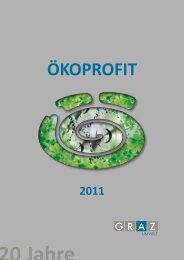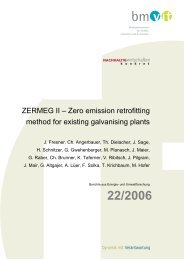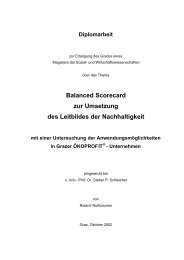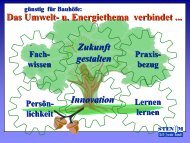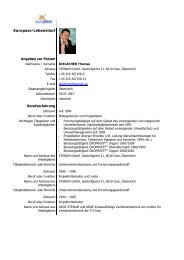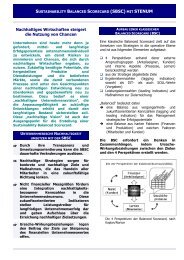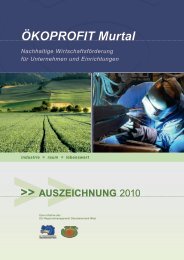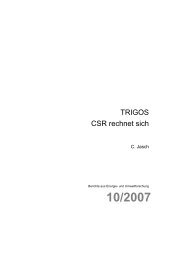Promoting Resource Efficiency in Small & Medium size ... - UNEP
Promoting Resource Efficiency in Small & Medium size ... - UNEP
Promoting Resource Efficiency in Small & Medium size ... - UNEP
Create successful ePaper yourself
Turn your PDF publications into a flip-book with our unique Google optimized e-Paper software.
Detailed assessment: Materials efficiency<br />
6.1 WHAT:<br />
The challenge of sourc<strong>in</strong>g raw materials for<br />
SMEs<br />
Currently <strong>in</strong>dustrial countries around the world use between 31 –<br />
74 tonnes of materials per capita per year; as future access to such<br />
resources becomes more difficult, efficient use of materials will be<br />
recognised as an important factor <strong>in</strong> competition and <strong>in</strong>novation. 44<br />
Figure 35 shows the overall material basis of the global economy<br />
(<strong>in</strong>clud<strong>in</strong>g only used materials) between 1980 and 2005. Four<br />
material categories are separately shown: fossil fuels, metal<br />
ores, <strong>in</strong>dustrial and construction m<strong>in</strong>erals and biomass (from<br />
agriculture, forestry and fishery). The figure illustrates that<br />
global resource extraction grew more or less steadily over the<br />
past 25 years, from 40 billion tons <strong>in</strong> 1980 to 58 billion tons <strong>in</strong><br />
2005, represent<strong>in</strong>g an aggregated growth rate of 45%. However,<br />
growth rates were unevenly distributed among the ma<strong>in</strong> material<br />
categories. The extraction of metal ores showed the largest<br />
<strong>in</strong>crease (by more than 65%), <strong>in</strong>dicat<strong>in</strong>g the cont<strong>in</strong>ued importance<br />
of this resource category for <strong>in</strong>dustrial development. The <strong>in</strong>crease<br />
<strong>in</strong> biomass extraction was below the upward curve of the other<br />
categories. The share of renewable resources <strong>in</strong> total resource<br />
extraction is therefore decreas<strong>in</strong>g on a global level. 45<br />
Material efficiency <strong>in</strong> <strong>in</strong>dustrial production focuses on the amount<br />
of a particular material needed to produce a particular product.<br />
Mathematically it is the ratio of the product divided by the raw<br />
materials used – so the number is never smaller than one. Material<br />
efficiency can be improved either by reduc<strong>in</strong>g the amount of the<br />
material conta<strong>in</strong>ed <strong>in</strong> the f<strong>in</strong>al product (‘light weight<strong>in</strong>g’), or by<br />
reduc<strong>in</strong>g the amount of material that enters the production process<br />
but ends up <strong>in</strong> the waste stream. In a slightly broader sense, tak<strong>in</strong>g<br />
<strong>in</strong>to account the <strong>in</strong>dustrial production-consumption cycle, material<br />
efficiency can refer to the amount of virg<strong>in</strong> natural resources<br />
required for produc<strong>in</strong>g a given amount of product, with recycl<strong>in</strong>g of<br />
post-consumption waste material back <strong>in</strong>to production contribut<strong>in</strong>g<br />
to material efficiency.<br />
Three components of material efficiency can therefore be identified:<br />
• Light weight<strong>in</strong>g <strong>in</strong> the production process<br />
• Waste reduction <strong>in</strong> the production process<br />
• Recycl<strong>in</strong>g of material <strong>in</strong> the production-consumption<br />
cycle 46<br />
Some facts and figures<br />
Development of steel consumption<br />
The world steel <strong>in</strong>dustry has entered a new phase. The f<strong>in</strong>ished<br />
steel consumption <strong>in</strong> the five years s<strong>in</strong>ce the beg<strong>in</strong>n<strong>in</strong>g of 2000<br />
<strong>in</strong>creased by 233 million tonnes – an average annual rate of<br />
around 6%. This compares with a 1.2% average yearly rise <strong>in</strong> the<br />
three decades previous to the year 2000.<br />
Steel prices have <strong>in</strong>creased substantially and the <strong>in</strong>dustry is<br />
profitable; however, marg<strong>in</strong>s have been reduced due to the<br />
dramatic <strong>in</strong>crease <strong>in</strong> prices of raw materials and transportation.<br />
There are also some risks of shortages for scrap and coke. 47<br />
44) Wisions, Corporate Energy and Material <strong>Efficiency</strong>, 2006.<br />
45) Material Flows, Global resource extraction my material category, 2008.<br />
46) Peck, M. and Chipman, R., Industrial energy and material efficiency: What role for policies?, undated<br />
47) OECD, Recent Steel Market Developments, 2004.<br />
55




